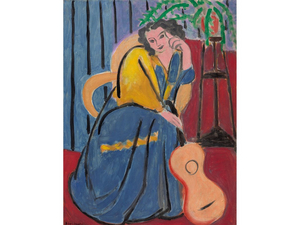The Jewish Museum to Present Afterlives: Recovering the Lost Stories of Looted Art
Afterlives will include works by major artists that were looted from Jewish collections during the war as well as treasured pieces of Judaica.

The Jewish Museum will present Afterlives: Recovering the Lost Stories of Looted Art, an exhibition that will situate the subject of art looting during World War II within a unique thematic premise, focusing on the seizure and movement of works as they traveled through distribution centers, sites of recovery, and networks of collectors, before, during, and after the war. The exhibition includes paintings, drawings, and Judaica that survived this traumatic period of violence and upheaval against tremendous odds. By tracing the fascinating timelines of individual objects as they passed through hands and sites, their myriad stories will be brought forward, often in dialogue with archival documents and photographs that connect them to history. The exhibition will be on view from August 20, 2021 through January 9, 2022.
During World War II untold numbers of artworks and pieces of cultural property were stolen by Nazi forces. After the war, an estimated one million artworks and 2.5 million books were recovered. Many more were destroyed. The exhibition and the accompanying catalogue trace the layered stories of the objects that survived, exploring the circumstances of their theft, their post-war rescue, and their afterlives in museums and private collections.Afterlives will include works by major artists that were looted from Jewish collections during the war as well as treasured pieces of Judaica. Rare examples of Jewish ceremonial objects from destroyed synagogues; works by such renowned artists as Pierre Bonnard, Marc Chagall, Paul Cézanne, Gustave Courbet, Paul Klee, Franz Marc, Henri Matisse, Pablo Picasso, and Camille Pissarro, among others; and rarely seen archival photographs and documents will all be on view.
The exhibition explores the important role the Jewish Museum played during and after the war in identifying and retrieving thousands of ritual objects that were looted from European synagogues and private residences.
One group of objects came to the Jewish Museum through Jewish Cultural Reconstruction, Inc. (JCR), an initiative begun in the mid-1940s to document and retrieve works salvaged after the war. JCR was responsible for finding homes for more than 350,000 books and 10,000 ceremonial objects (including 1,000 Torah scrolls) throughout the United States, Israel, and the world, thousands of which passed through the Jewish Museum, which acted as a storage depot for the organization. More than 200 of those objects entered the Museum's own permanent collection. Another group came to the Jewish Museum via the Jewish community of Danzig (now Gdansk in Poland). Facing increasingly aggressive persecution and forced to dissolve the contents of its Great Synagogue, members of the community in cooperation with the American Jewish Joint Distribution Committee shipped ten crates of material to the Jewish Theological Seminary in New York in 1939. While hope remained that the community would be reestablished in Danzig after the war, that proved impossible, and the material was formally accessioned by the Jewish Museum in 1954. A selection of objects from both sources will be displayed in Afterlives, along with material from the Museum's archives documenting their fascinating histories.
The Jewish Museum has also commissioned four contemporary artists to create new works that address the resonance of the exhibition's themes. Maria Eichhorn's (German, b. 1962) site-specific installation incorporates looted books and archival documents and highlights the role of such intellectuals as Hannah Arendt in the recovery effort. Hadar Gad (Israel, b. 1960) considers the connections between memory and place in a series of large-scale paintings based on archival photographs taken at various sites of dispossession and repossession. Dor Guez (Israel, b. 1980) mines his own familial past, which combines both Christian Palestinian and Tunisian Jewish histories, in objects and photographs that address the role of language, images, and material culture as reference points for identity. And Lisa Oppenheim (United States, b. 1975) unpacks the role of photography in mediating loss by appropriating archival photographs that document the destruction and disappearance of individual artworks.
Visit TheJewishMuseum.org for more information.

Videos
